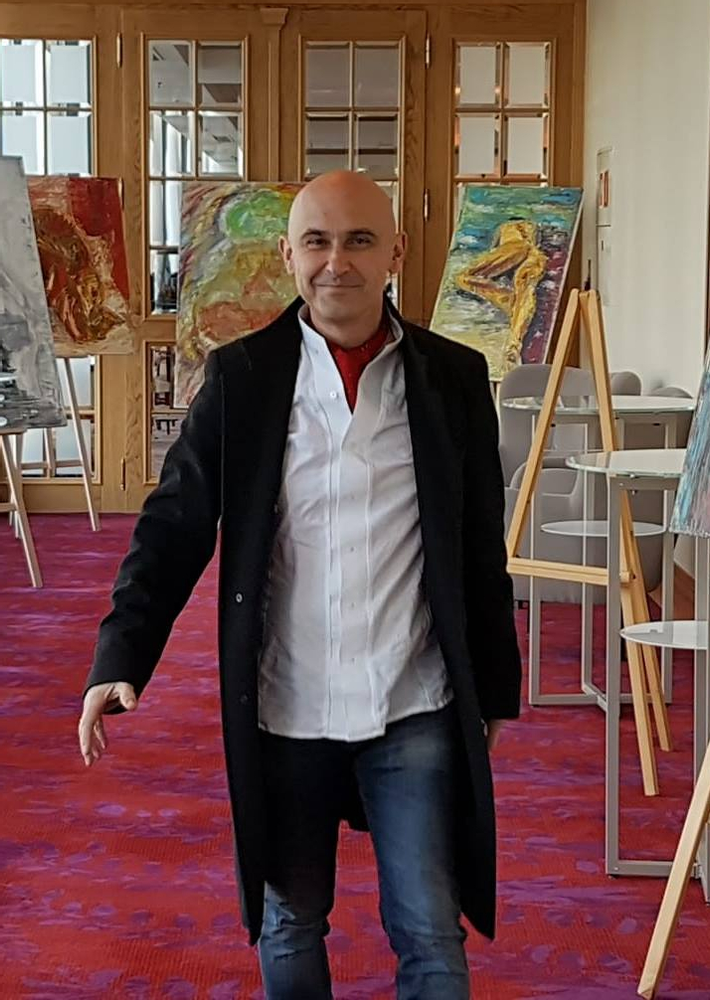
Krzystof Konopka
Il percorso artistico del polacco Krzysztof Konopka è iniziato qualche anno fa in modo del tutto casuale, a seguito di un pellegrinaggio verso Santiago de Compostela che per lui non fu un andare verso il luogo sacro per chiedere qualcosa o liberarsi da qualche nodo del passato bensì rappresentò semplicemente un mettersi in viaggio con l’intenzione di approfondire la conoscenza di se stesso, di meditare su un sé inconscio che aspettava di rivelarsi. Al suo ritorno da quel cammino sentì il forte impulso di acquistare una tela, dei colori e dei pennelli, senza che ne avesse mai avuto desiderio in precedenza, e quel momento segnò l’inizio di una carriera artistica che lo vede oggi protagonista e fondatore di un pensiero filosofico, un approccio alla creazione dell’opera che sta tracciando una tendenza e aprendo una nuova strada nel mondo dell’Astrattismo. Nelle sue tele a volte la figurazione emerge in modo più incisivo ed evidente perché il messaggio che il suo impulso lo spinge a lasciare all’osservatore è più chiaro, meno nascosto dalle pieghe della sua forte emotività; in altre al contrario si entra nel mondo del puro astrattismo poiché sono le sensazioni, l’istinto creativo a dettare il ritmo pittorico, a suggerire all’artista quali impressioni liberare e lasciar fluire liberamente.
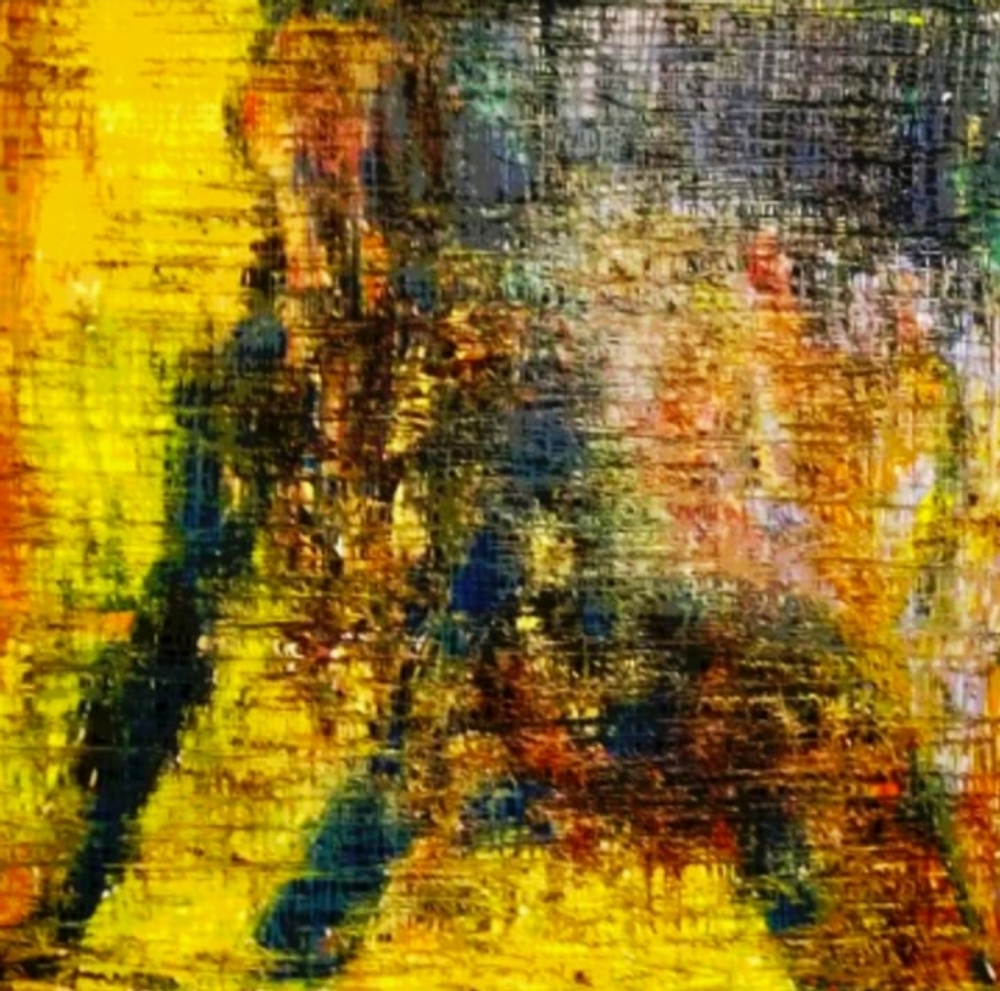
Wolf
Quando Krzysztof Konopka si chiude nel suo studio con pennelli e colori lascia andare ogni contatto con la ragione, con quella parte razionale che spesso costituisce un filtro, un freno al libero fluire, e si connette con la sua voce interiore, con il mondo irrazionale in cui l’unico senso è quello di trasformare l’autore dell’opera in semplice esecutore, mano di un contatto più primordiale con quel lato intimo e passionale che rappresenta la vera essenza di ciascuno. La stesura del colore è densa, le tonalità utilizzate sono intense, forti, proprio per sottolineare quanto il mondo delle emozioni non possa essere mitigato, stemperato o filtrato da alcun momento di riflessione bensì debba essere semplicemente ascoltato e manifestato nella sua spontaneità e immediatezza; solo in un secondo tempo, dopo la prima stesura, l’artista agisce sul colore tracciando dei veri e propri graffi che rappresentano la presa di coscienza da parte dell’esecutore di essere nel momento presente, la consapevolezza di ciò che l’istinto ha generato e sul cui concetto comincia ad agire. Nella poetica artistico-espressiva di Krzysztof Konpka è fondamentale mettersi in contatto e in ascolto dell’energia quantica che spesso ci si dimentica di notare ma che è la sottile connessione con le infinite possibilità e opzioni dell’essere, grazie alla quale possiamo aprirci alla consapevolezza di essere in grado di determinare un cambiamento, una modifica che sia essa di tipo interiore, e per questo funzionale a lasciar emergere una coscienza differente del proprio punto di vista più o meno razionale, oppure di tipo esistenziale, e in quel caso a seguito della nuova presa d’atto diventa possibile effettuare un’evoluzione che può modificare tutto.
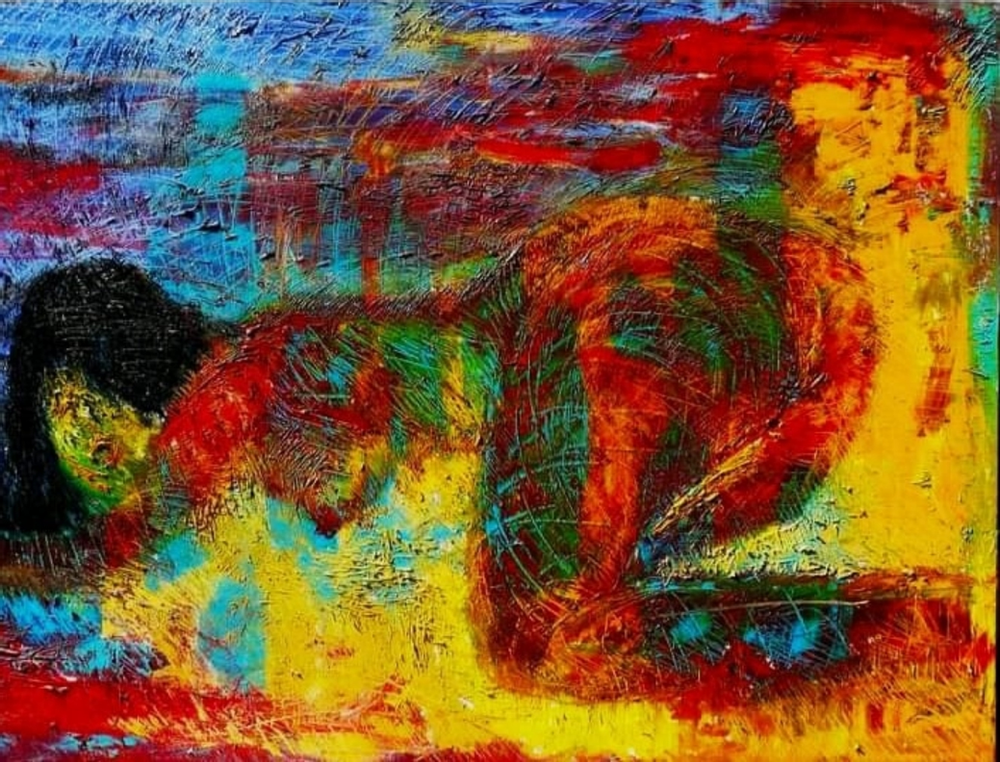
Confession
Secondo questo particolare processo l’opera d’arte diviene elemento funzionale a prendere e aumentare la conoscenza di sé dell’artista, ma anche del dipinto generato, del suo messaggio più profondo che emerge solo nella fase finale, quella in cui l’esecutore rientra nella sua fase razionale e consapevole e osserva dal di fuori tutto ciò di cui l’impulso ha parlato, ha gridato o ha sussurrato, sulla base di quanto forte fosse la necessità e l’urgenza di manifestare se stesso. Il procedimento creativo e, di fatto, filosofico ideato da Krzysztof Konopka prende il nome di Orapismo di cui ci parlerà direttamente l’artista.
Cosa significa il termine Orapismo, qual è la sua origine e quale il pensiero filosofico che si nasconde dietro questo termine?
L’orapismo è uno strumento per tracciare la propria mente cosciente; attinge al concetto che le energie intorno a noi in qualche modo danno tracce e suggerimenti sul nostro agire perciò è importanti mettersi in una posizione di ascolto durante la quale la parte razionale e consapevole è inattiva. È un atto di connessione creativa con lo spazio, inteso come campo quantistico, e solo in un secondo momento entra in gioco la mente cosciente che assume consapevolezza di tutto ciò che la fase inconscia ha generato. Il nome di questo mio approccio pittorico deriva dalla frase portoghese Ora pista che significa da tracciare ora. Il concetto filosofico che emerge è legato al principio quantico attraverso il quale la mente ha bisogno di aprirsi per scoprire le sue illimitate potenzialità; nel momento in cui si percepisce la spinta alla creazione di qualcosa di illimitato, diventa necessario sperimentare la mancanza di limitazioni che si verifica solo quando la razionalità è messa in una posizione di riposo e il sentire interiore si pone in connessione con la sua parte più istintiva, emozionale e inconsapevole.

Barbat
Ci racconta quali sono le fasi dell’Orapismo e quali gli elementi essenziali per la sua attuazione?
Durante il meccanismo di azioni memorizzate a livello muscolare e pensiero abituale, il che significa usare la mente subconscia, il creatore abbozza con una matita – indipendentemente dalle sue capacità artistiche – la storia, le figure, gli elementi, i segni o le forme sul sub-pittura.
Senza pensare alla qualità e allo spessore della linea, il creatore applica una vernice monocolore con movimenti rapidi e costanti. La rivelazione è necessaria per immergersi nella propria coscienza, è la disponibilità interna del creatore a entrare nel momento presente e così l’esecutore stesso dell’opera diventa la punta, diventa l’estremità della sua spatola. Bisogna uscire da se stessi, ed essere nel momento presente: Orapismo, ora-scrittura, tracciare Ora, scrivere Ora. Solo chi è veramente presente, chi volta le spalle a tutto ciò che è conosciuto, diventa la “coscienza pura”. Nel Qui e Ora manca la realtà quadridimensionale. L’attenzione del creatore è Qui, dove si concentra l’energia. Vibrando in questo stato, il creatore si arrende e accetta incondizionatamente il lavoro che viene dalle punte dei suoi strumenti. La re-immaginazione dei contorni imperfetti dello schizzo precedentemente perfetto. Da questo momento il creatore esiste nella fase dell’Orapismo chiamata Inazione. Cessa di esistere come separato da ciò che lo circonda e comincia ad unirsi all’energia quantica del Tutto. Quindi, il pensiero, il creatore, la tela, gli strumenti e l’ambiente circostante diventano la stessa energia. In questa esperienza di connessione con il campo quantico, è possibile osservare la formazione del risultato dell’atto istintivo precedente, che si manifesta con linee raschiate formando così una sub-pittura sulla pittura precedente, intuitivamente, sconsideratamente, impulsivamente, caoticamente, energicamente, dispendiosamente, ondulatamente, riccamente, coloratamente applicata con una spatola.
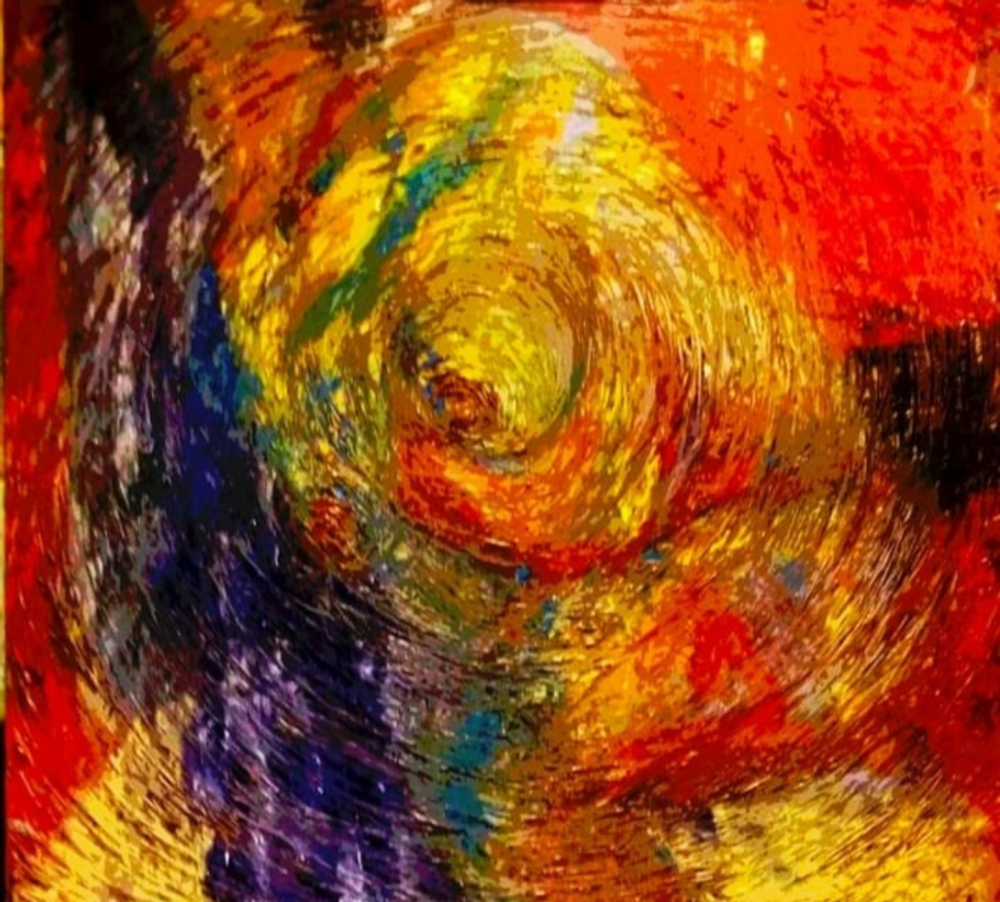
Vortex
Questa forma primitiva di espressione insieme allo sviluppo di una mente cosciente, prende delle forme imprevedibili e sofisticate. Il tratto caratteristico dell’ultima fase creativa dell’Orapismo è l’improvvisa separazione della suddetta unione tra il creatore e la creazione e il notevole ritorno del creatore allo spazio quadridimensionale. Staccandosi dal quadro, il creatore termina l’atto artistico di connessione con la propria coscienza.
L’analisi del contenuto, che è lo studio dell’opera creata, permette al creatore di rintracciarsi nella coscienza, e di iniziare il cambiamento cosciente in una mente subconscia. Quando si entra nella fase di Inazione il creatore permette alla razionalità di scoprire i cambiamenti tra il mondo abituale della mente subconscia e il mondo illusorio della mente cosciente. Dunque, per riassumere, le fasi dell’Orapismo sono:
La Mente Subconscia che rappresenta i programmi precedenti, i comportamenti abituali che conducono automaticamente la nostra vita.
Il Disegno che scaturisce dal programma e attinge dalla mente subconscia.
La Pittura che è la prova materializzata della connessione tra il creatore, la creazione e il campo quantico.
L’Inazione, la fase principale dell’Orapismo, senza la quale il dipinto non può essere considerato parte dell’Orapismo.
Quanto è importante nel processo creativo, ma anche nell’esistenza quotidiana, essere nel momento presente? Cosa comporta questo tipo di approccio?
Il processo creativo è una parte innata della coscienza umana, cioè la coscienza senza pensiero. Prima di imparare il concetto, i bambini acquisiscono il senso dello spazio e tutti hanno la stessa essenza di coscienza dentro di loro. Il potere del presente si svela scoprendo modi diversi per trovare la nostra libertà di identificarci con la mente pensante. Quando non si pensa a qualcosa, la si fa. La fonte principale della nostra sofferenza e della confusione della vita deriva dall’errata
convinzione che noi siamo il contenuto dei nostri pensieri. Questa incredibile convinzione costrittiva taglia fuori l’intelligenza superiore, ci sono già alcune persone che non hanno nulla a che fare con le arti visive che hanno deciso di intraprendere l’Orapismo. Nell’Orapismo voglio convincere tutti che possono usare la loro coscienza, rinunciando agli schemi preesistenti per creare un quadro individuale delle loro esperienze e lasciarsi andare all’analisi del loro spazio attuale. Per trovare l’inarrestabile gioia di creare. Basta liberare la mente dall’imbarazzo di noi e del nostro critico interiore. Questo è il motto di Orapism: Essere il testimone della propria creatività.
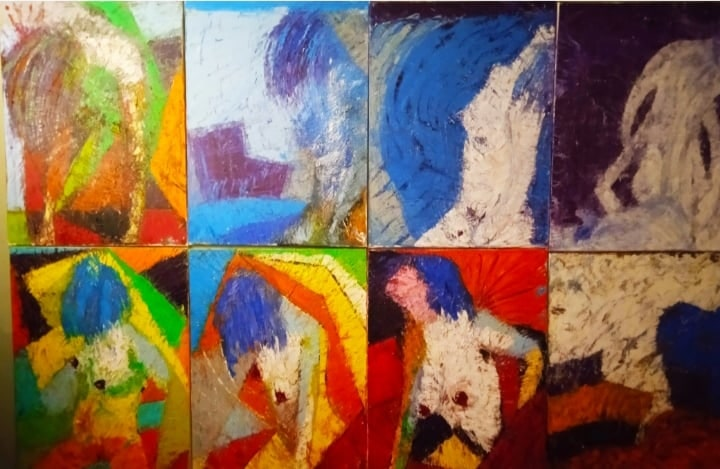
Chakras
Lei ha scoperto il suo naturale talento artistico molto tardi e a seguito di un viaggio che per molti rappresenta una speranza mentre per lei ha rappresentato un inconsapevole punto di arrivo verso un nuovo sé che non conosceva. Ci vuole raccontare le sensazioni provate durante quell’importante percorso?
La spinta a compiere il cammino verso Santiago de Compostela è nata improvvisamente, senza lo scopo che induce molte altre persone a effettuare quel pellegrinaggio, io ho semplicemente sentito il desiderio di andare, intuendo che l’esperienza avrebbe generato una riflessione profonda e un cambiamento dentro di me. E così è stato, sono rientrato a casa con una coscienza differente, ho ricevuto il dono di una rivelazione che mi ha spinto verso la pittura, verso l’espressione creativa che in precedenza non sapevo di avere. Ho appreso in quel percorso che una rivelazione determina e genera sempre un cambiamento improvviso, una modificazione evidente, quindi è indiscutibile, è necessario attuarlo, quasi in maniera irresistibile e così ho cominciato il mio cammino nell’arte che oggi mi rende felice perché riconosco essere la mia strada, ciò che mai avrei immaginato di poter fare prima di intraprendere quel viaggio.
Quali sono i prossimi progetti? Come crede di valorizzare e diffondere il suo Orapismo?
Vorrei che l’Orapismo si diffonda il più possibile e a un numero sempre maggiore di artisti e di persone, per dar vita a un modo consapevole di comunicare con se stessi e, di conseguenza con gli altri, per questo sto cercando di impiegare tutte le mie energie per diffondere questo messaggio che oltre a un modo di fare arte è anche un modo di intendere l’esistenza.
KRZYSZTOF KONOPKA-CONTATTI
Email: orapizm@gmail.com
Sito web: www.orapizm.art
Facebook: https://www.facebook.com/krzysztof.konopka.7902
Instagram: https://www.instagram.com/orapizm/
Marta Lock’s interviews:
Krzysztof Konopka, the new way of interpreting Abstractionism
The artistic career of the Polish artist Krzysztof Konopka began a few years ago by chance, following a pilgrimage to Santiago de Compostela, which for him was not a pilgrimage towarsd the holy place to ask for something or to free himself from some knot of the past, but was simply a journey with the intention of deepening his knowledge of himself, of meditating on an unconscious self that was waiting to reveal itself. On his return from that journey he felt a strong urge to buy a canvas, paints and brushes, without ever having had the desire to do so before, and that moment marked the beginning of an artistic career that today sees him as the protagonist and founder of a philosophical thought, an approach to the creation of artwork that is setting a trend and opening a new road in the world of Abstractionism. In his canvases, sometimes figuration emerges in a more incisive and evident way because the message that his impulse urges him to leave to the observer is clearer, less hidden by the folds of his strong emotionality; in others, on the contrary, one enters the world of pure abstractionism because it is the sensations, the creative instinct that dictate the pictorial rhythm, suggesting to the artist which impressions to release and allow to flow freely. When Krzysztof Konopka closes himself up in his studio with brushes and colours, he lets go every contact with reason, with that rational side that often constitutes a filter, a brake on free flow, and connects with his inner voice, with the irrational world in which the only sense is that of transforming the author of the artwork into a simple executor, the hand of a more primordial contact with that intimate and passionate side that represents the true essence of each of us. The colour is thickly applied, the shades used are intense and strong, precisely to underline how the world of emotions cannot be mitigated, diluted or filtered by any moment of reflection, but must simply be listened to and manifested in its spontaneity and immediacy; only later, after the first draft, the artist acts on the colour, tracing real scratches that represent the performer’s consciousness of being in the present moment, the awareness of what instinct has generated and on whose concept he begins to act. In the artistic-expressive poetics of Krzysztof Konpka it is fundamental to get in touch with and listen to the quantum energy that we often forget to notice but that is the subtle connection with the infinite possibilities and options of being, thanks to which we can open ourselves to the sensibilness of being able to bring about a change, a modification, be it of an inner nature and therefore functional to allow a different consciousness of one’s own more or less rational point of view to emerge, or of existential nature, and in that case following the new aknowledgment it becomes possible to carry out an evolution that can change everything. According to this particular process, the artwork becomes a functional element to take and increase the self-knowledge of the artist, but also of the painting generated, of its deeper message that emerges only in the final phase, the one in which the performer returns to his rational and conscious phase and observes from the outside all that the impulse has spoken, has shouted or has whispered, depending on how strong was the need and the urgency to manifest itself. The creative and, in fact, philosophical procedure devised by Krzysztof Konopka is called Orapism, which the artist will tell us about directly.
What does the term “Orapism” mean? What is its origin and what philosophical thought lies behind it?
Orapism is a tool for tracing one’s conscious mind; it draws on the concept that the energies around us somehow give signs and suggestions about our actions so it is important to put oneself in a listening position during which the rational and conscious part is inactive. It is an act of creative connection with space, understood as a quantum field, and only later does the conscious mind come into play and become aware of all that the unconscious phase has generated. The name of this pictorial approach of mine comes from the Portuguese phrase Ora pista which means to trace now. The philosophical concept that emerges is linked to the quantum principle through which the mind needs to open up in order to discover its unlimited potential; at the moment in which the urge to create something unlimited is perceived, it becomes necessary to experience the lack of limitations that only occurs when rationality is placed in a position of rest and the inner feeling connects with its more instinctive, emotional and unconscious part.
Can you tell us what are the stages of Orapism and which are the essential elements for its implementation?
During the mechanism of memorised actions at a muscular level and habitual thinking, which means using the subconscious mind, the creator sketches out with a pencil – regardless of his artistic ability – the story, figures, elements, signs or shapes on the sub-painting.
Without thinking about the quality and thickness of the line, the creator applies a single-colour paint with rapid and constant movements. Revelation is necessary to immerse oneself in one’s own consciousness, it is the creator’s inner willingness to enter the present moment and thus the very executor of the artwork becomes the tip, becomes the end of his spatula. One must come out of oneself, and be in the present moment: Orapism, now-writing, drawing Now, writing Now. Only who is truly present, who turns his back on all that is known, becomes the “pure consciousness”. In the Here and Now, the four-dimensional reality is missing. The attention of the creator is Here, where the energy is concentrated. Vibrating in this state, the creator surrenders and unconditionally accepts the work coming from the tips of his tools. The re-imagination of the imperfect contours of the previously perfect sketch. From this moment on, the creator exists in the phase of Orapism called Inaction. He ceases to exist as separate from his surroundings and begins to unite with the quantum energy of the Whole. Thus, the thought, the creator, the canvas, the tools and the surroundings become the same energy. In this experience of connection with the quantum field, it is possible to observe the formation of the result of the previous instinctive act, which manifests itself with scraped lines forming a sub-painting on top of the previous painting, intuitively, thoughtlessly, impulsively, chaotically, energetically, wastefully, undulatingly, richly, colourfully applied with a palette knife. This primitive form of expression, together with the development of a conscious mind, takes on unpredictable and sophisticated forms. The characteristic feature of the last creative phase of Orapism is the sudden separation of the aforementioned union between creator and creation and the remarkable return of the creator to four-dimensional space. By detaching himself from the painting, the creator ends the artistic act of connecting with his own consciousness.
The analysis of the content, which is the study of the created artwork, allows the creator to trace himself back into consciousness, and to begin the conscious change into a subconscious mind. When entering the Inaction phase the creator allows rationality to discover the changes between the habitual world of the subconscious mind and the illusory world of the conscious mind. So, to summarise, the stages of Orapism are:
The Subconscious Mind which represents the previous programmes, the habitual behaviours that automatically lead our lives.
The Drawing which springs from the programme and draws from the subconscious mind.
The Painting which is the materialised proof of the connection between the creator, the creation and the quantum field.
The Inaction, the main phase of Orapism, without which the painting cannot be considered part of Orapism.
How important is it in the creative process, but also in everyday existence, to be in the present moment? What does this approach entail?
The creative process is an innate part of human consciousness, that is, consciousness without thought. Before learning the concept, children acquire a sense of space and all have the same essence of consciousness within them. The power of the present is revealed by discovering different ways to find our freedom to identify with the thinking mind. When you don’t think about something, you do it. The main source of our suffering and confusion in life comes from the mistaken belief that we are the content of our thoughts. This incredible constricting belief cuts off the higher intelligence, there are already some people who have nothing to do with the visual arts who have decided to take up Orapism. In Orapism I want to convince everyone that they can use their consciousness, renouncing pre-existing patterns to create an individual picture of their experiences and allow themselves to analyse their current space. To find the unstoppable joy of creating. Just free your mind from the embarrassment of us and our inner critic. This is the motto of Orapism: Be the witness of your own creativity.
You discovered your natural artistic talent very late in life and after a journey that for many people is a hope, but for you was an unconscious point of arrival into a new self that you did not know. Would you like to tell us about the feelings you experienced during that important journey?
The thrust to make the journey to Santiago de Compostela came suddenly, without the purpose that prompt many other people to make that pilgrimage, I simply felt the desire to go, sensing that the experience would generate deep reflection and a change within me. And so it was, I returned home with a different consciousness, I received the gift of a revelation that pushed me towards painting, towards creative expression that I did not know I had before. I learned on that journey that a revelation always determines and generates a sudden change, an evident modification, so it is indisputable, it is necessary to implement it, almost irresistibly, and so I began my journey in art, which today makes me happy because I recognise it as my path, what I would never have imagined I could do before embarking on that journey.
Which are your next projects? How do you intend to enhance and popularise your Orapism?
I would like Orapism to spread as far as possible and to an ever increasing number of artists and people, to create a conscious way of communicating with oneself and, consequently, with others, which is why I am trying to put all my energy into spreading this message, which is not only a way of making art but also a way of looking at existence.
